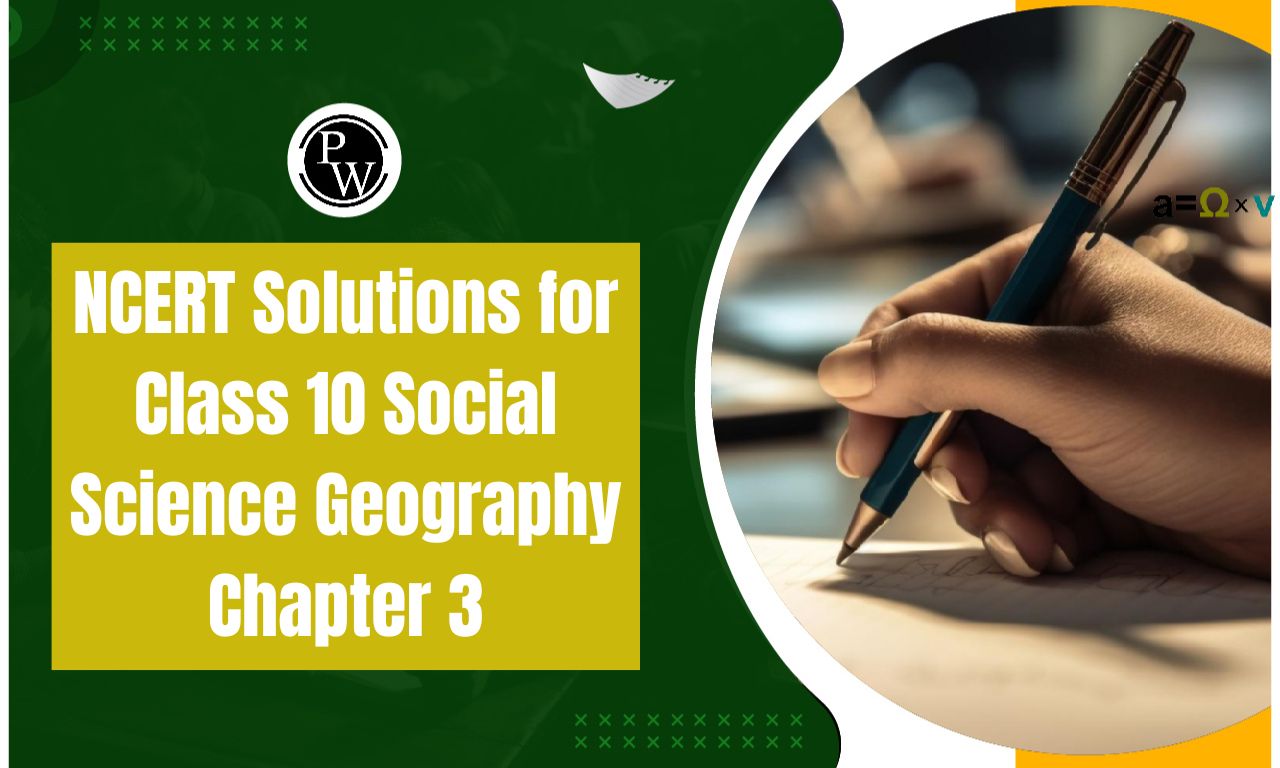

NCERT Solutions for Class 10 Science Chapter 9: NCERT Solutions for Class 10 Science Chapter 9 Heredity and Evolution provide students with a comprehensive understanding of genetic inheritance and the process of evolution.
It covers key topics including the role of DNA in heredity, the significance of genes and chromosomes, and the mechanisms of genetic variation and evolution. The solutions provide clear explanations and step-by-step guidance to help students grasp complex concepts and solve problems effectively. By working through these solutions students can enhance their comprehension of how traits are inherited and how evolutionary processes shape the diversity of life.NCERT Solutions for Class 10 Science Chapter 9 Heredity and Evolution Overview
NCERT Solutions for Class 10 Science Chapter 9 Heredity and Evolution prepared by the experts of Physics Wallah provide a clear and simple explanation of how traits are inherited and how evolution happens. These solutions cover important topics like Mendel's experiments, how DNA works, and different patterns of inheritance. They also explain genetic changes and how species evolve over time. With these solutions, students can easily understand and solve problems related to heredity and evolution, helping them build a strong foundation in these essential scientific concepts.NCERT Solutions for Class 10 Science Chapter 9 PDF Download
The PDF link for the NCERT Solutions for Class 10 Science Chapter 9, "Heredity and Evolution," provides a comprehensive resource for students seeking detailed explanations of the chapter's key concepts. This PDF includes solutions to various exercises and questions from the chapter, which covers essential topics like Mendelian genetics, inheritance patterns, and evolutionary theories . By using this PDF, students can access well-organized, step-by-step solutions that clarify complex concepts and assist in mastering the subject effectively.NCERT Solutions for Class 10 Science Chapter 9 Heredity and Evolution PDF
NCERT Solutions for Class 10 Science Chapter 9 Heredity and Evolution
Here, we have provided NCERT Solutions for Class 10 Science Chapter 9 to help students prepare more effectively for their exams.NCERT Solutions for Class 10 Science Chapter 9 Exercises 9.1 Page: 143
1. If a trait A exists in 10% of a population of an asexually reproducing species and trait B exists in 60% of the same population, which trait is likely to have arisen earlier?
Solution: Trait B is more likely to appear early because it is already prevalent and replicating in a larger portion of the population compared to trait A. This higher existing frequency and replication rate make Trait B more common and more likely to manifest sooner.
2. How does the creation of variations in a species promote survival?
Solution:
Genetic variations help species adapt more effectively to changes in their environment. These variations are crucial for evolution because they influence how allele frequencies shift through natural selection. By enabling species to better adjust to new conditions, genetic variations play a key role in determining whether a species will continue to thrive or face extinction.NCERT Solutions for Class 10 Science Chapter 9 Exercises 9.2 Page: 147
1. How do Mendel’s experiments show that traits may be dominant or recessive?
Solution:
Mendel demonstrated that traits can be either dominant or recessive through his experiments with pea plants, focusing on a mono-hybrid cross. He crossed tall (TT) pea plants with dwarf (tt) pea plants. The resulting F1 generation plants were all tall, indicating that the tall trait was dominant. When Mendel self-pollinated these F1 plants, the F2 generation showed a ratio where 1/4 of the plants were dwarf. This result led Mendel to conclude that the F1 tall plants were not true-breeding but carried both tall and dwarf traits. The dominance of the tall trait over the dwarf trait reinforced the idea that traits can be categorized as dominant or recessive.2. How do Mendel’s experiments show that traits are inherited independently?
Solution:
3. A man with blood group A marries a woman with blood group O, and their daughter has blood group O. Is this information enough to tell you which of the traits – blood group A or O – is dominant? Why or why not?
Solution:
Based on the information provided, we can determine the dominance relationships between blood types:Blood Type A vs. Blood Type O:
- Blood Type A is dominant.
- Blood Type O is recessive.
Possible Genotypes:
- For Blood Type A : The genotype can be either AA (homozygous) or AO (heterozygous).
- For Blood Type O : The genotype must be OO (homozygous recessive).
Parental Genotypes:
- Father's Blood Type : Could be either AA or AO .
- Mother's Blood Type : Could be either OA or OO .
Implications for Offspring:
- If the father is AA and the mother is OO , all offspring will have the genotype AO , resulting in Blood Type A.
- If the father is AO and the mother is OO , there is a 50% chance for each offspring to have Blood Type A (genotype AO ) and a 50% chance to have Blood Type O (genotype OO ).
4. How is the sex of the child determined in human beings?
Solution:
In humans, the determination of a child's sex is indeed influenced by the chromosomes contributed by both parents, but it's crucial to understand the roles of the X and Y chromosomes in this process:Chromosomal Combinations:
- Males have one X and one Y chromosome (XY).
- Females have two X chromosomes (XX).
Sex Determination:
- When a male's X chromosome combines with a female's X chromosomes (XX), the combination results in XX, which means the child will be female (a girl).
- When a male's Y chromosome combines with a female's X chromosome (XX), the combination results in XY, which means the child will be male (a boy).
NCERT Solutions for Class 10 Science Chapter 9 Exercises 9.3 Page: 150
1. What are the different ways in which individuals with a particular trait may increase in a population?
Solution:
An individual attribute can contribute to the increase of a population in two main ways:(a) Natural Selection:
- Mechanism: If an attribute provides a survival or reproductive advantage, it will become more common in the population over time. This happens because individuals with beneficial traits are more likely to survive and reproduce, passing these advantageous traits to their offspring.
- Example: Consider mosquitoes that have developed resistance to a specific pesticide. These resistant mosquitoes are more likely to survive and reproduce compared to those that are susceptible. Over time, the resistance trait becomes more prevalent in the population because the susceptible mosquitoes die out, and the resistant ones pass on their genes to future generations.
(b) Genetic Drift:
- Mechanism: Genetic drift refers to random changes in allele frequencies within a population, particularly in small populations or after a catastrophic event. When a significant portion of the population is lost, the surviving individuals may have different allele frequencies than the original population. The traits of the survivors become more common in future generations purely due to chance.
- Example: If a natural disaster drastically reduces a mosquito population, the surviving mosquitoes will have a different genetic makeup compared to the original population. Traits present in these survivors can become more common in future generations, even if these traits were not necessarily advantageous. For instance, if the survivors had a certain genetic trait, that trait may become more prevalent in the population simply because the survivors carried it.
2. Why are traits acquired during the lifetime of an individual not inherited?
Solution:
Traits acquired during an individual's lifetime cannot be inherited by successive generations because these changes do not alter the DNA of the germ cells (sperm or egg cells). The genetic information passed to offspring comes from the DNA of these germ cells, which remains unchanged by experiences or skills acquired during the individual's lifetime.Example: If a football player develops exceptional skills through practice and training, these skills are not encoded in the DNA of his germ cells. Therefore, his children will not inherit these football skills. Instead, the traits passed to the next generation are those encoded in the genetic material of the germ cells, such as eye color, height, and other inherited characteristics, but not acquired abilities or experiences.
3. Why are the small numbers of surviving tigers a cause of worry from the point of view of genetics?
Solution:
As the size of the tiger population decreases, the genetic pool of the species also shrinks. This reduction in genetic diversity limits the range of variations within the tiger population. When genetic diversity is low, the population is more vulnerable to diseases and environmental changes. For instance, if a disease emerges and the population lacks genetic variation, there may be no individuals with genetic resistance to the illness. This can lead to widespread illness and potentially result in the extinction of the entire population. Thus, maintaining a healthy population size is crucial for preserving genetic diversity and ensuring the survival of the species.NCERT Solutions for Class 10 Science Chapter 9 Exercises 9.4 Page: 151
1. What factors could lead to the rise of a new species?
Solution:
The factors that contribute to the formation of a new species include: (a) Mutation : Changes in the DNA sequence can introduce new traits into a population. Over time, these mutations can accumulate and lead to the development of new species if they provide a reproductive advantage or are beneficial in a given environment. (b) Genetic Drift : Random changes in allele frequencies within a population, particularly in small populations, can lead to the emergence of new traits and potentially new species over time. This process is less about adaptation and more about chance. (c) Natural Selection : This process favors individuals with traits that are advantageous in their environment, leading to an increased prevalence of these traits in the population. Over long periods, natural selection can drive significant changes and lead to the formation of new species. (d) Geographical Isolation : When populations of a species are separated by geographical barriers (such as mountains or rivers), they evolve independently. This isolation can lead to significant genetic differences and, eventually, the emergence of new species. (e) Generative Isolation for Prolonged Periods : If populations remain isolated from one another for extended periods, they may develop unique traits and adaptations. This prolonged isolation can eventually result in reproductive isolation, where individuals from different populations can no longer interbreed, leading to the formation of new species. (f) Environmental Factors on the Isolated Populations : Environmental pressures, such as climate change or habitat changes, can affect isolated populations differently. These pressures can lead to adaptations that contribute to the development of new species. (g) Quantum of Genetic Variant Transmissible from One Generation to the Following Generation : The amount and type of genetic variation that is passed on from one generation to the next can influence evolutionary outcomes. High levels of genetic variation provide a broader range of traits for natural selection to act upon, potentially leading to the formation of new species.2. Will geographical isolation be a major factor in the speciation of a self-pollinating plant species? Why or why not?
Solution:
3. Will geographical isolation be a major factor in the speciation of an organism that reproduces asexually? Why or why not?
Solution:
In the case of asexually reproducing organisms, geographical isolation does not play a significant role in introducing genetic variation. This is because asexual reproduction does not involve meiosis, which is the process that leads to genetic recombination and variation in sexually reproducing organisms. In asexual reproduction, an organism produces offspring that are genetically identical to itself, as there is no mixing of genetic material from two different parents. As a result, even if a population is geographically isolated, the genetic makeup of the individuals remains largely unchanged. This lack of genetic recombination means that geographical isolation cannot contribute to new genetic traits or variations in the same way it can for sexually reproducing organisms. While geographical isolation might affect environmental factors and selective pressures, these changes do not lead to genetic variation in asexually reproducing organisms. Instead, any potential adaptation to the new environment would be a result of mutations rather than the benefits of genetic diversity from meiosis.NCERT Solutions for Class 10 Science Chapter 9 Exercises 9.5 Page: 156
1. Give an example of characteristics being used to determine how close two species are in evolutionary terms.
Solution:
Chimpanzees are remarkable for their ability to express a wide range of emotions, such as laughter and smiling, traits once thought to be exclusive to humans. Their smiles, characterized by the activation of the brain’s limbic system and the involuntary contraction of the orbicularis oculi muscle, are genuine and known as Duchenne smiles. This reflects a deep-seated emotional expression similar to that seen in humans. Interestingly, chimpanzees and humans share 98.6% of their DNA, indicating a close evolutionary relationship. This significant genetic overlap suggests that humans and chimpanzees evolved from a common ancestor millions of years ago. As a result, chimpanzees are considered our closest living relatives, offering valuable insights into our own evolutionary history and the emotional traits we share.2. Can the wing of a butterfly and the wing of a bat be considered homologous organs? Why or why not?
Solution:
The wings of a butterfly and a bat are examples of analogous organs, not homologous organs. Although both types of wings serve the function of flight, they evolved independently from different ancestral structures. The wings of a butterfly are made of chitinous membranes, while the wings of a bat are supported by a bony skeleton with blood vessels. This difference in structure highlights their separate evolutionary paths. Thus, while they perform similar functions, their origins and anatomical structures differ significantly, making them analogous rather than homologous organs.3. What are fossils? What do they tell us about the process of evolution?
Solution:
Fossils are the preserved remains of ancient plants, animals, or other organisms that lived millions of years ago. They provide valuable insights into extinct species and help us understand the process of evolution. By studying fossils, scientists can learn about how these ancient organisms lived, what they looked like, and how they are related to modern species. For example, the recovery of protein sequences from a T. rex fossil revealed its connection to birds, showing that birds are descendants of avian dinosaurs. The distribution of fossils across different layers of rock helps us trace the timeline of when various species appeared or went extinct, offering a window into the history of life on Earth.NCERT Solutions for Class 10 Science Chapter 9 Exercises 9.6 Page: 158
1. Why are human beings who look so different from each other in terms of size, colour and looks said to belong to the same species?
Solution:
While human beings exhibit a wide range of colors and physical appearances, our genetic makeup remains remarkably similar across the entire species. The variations in skin color, facial features, and other traits are largely influenced by evolutionary pressures. One theory suggests that these differences evolved to help individuals in various environments be easily recognized by others. For instance, distinct facial features might have enhanced social interactions or identification within groups. Despite these external differences, all humans share a common genetic foundation, which underscores our shared species identity.2. In evolutionary terms, can we say which among bacteria, spiders, fish and chimpanzees have a ‘better’ body design? Why or why not?
Solution:
Body designs are shaped by the specific environmental needs and pressures faced by different organisms. Consequently, it is not accurate to claim that one organism has a better body design compared to another. For example, fish have evolved streamlined bodies that are perfectly suited for swimming in aquatic environments. This design minimizes resistance and enhances their ability to move through water efficiently. In contrast, spiders and chimpanzees have body structures adapted to their respective environments—terrestrial and arboreal—making them ill-suited for aquatic life.NCERT Solutions for Class 10 Science Chapter 9 Exercises Page: 159
1. A Mendelian experiment consisted of breeding tall pea plants bearing violet flowers with short pea plants bearing white flowers. The progeny all bore violet flowers, but almost half of them were short. This suggests that the genetic makeup of the tall parent can be depicted as
(a) TTWW
(b) TTww
(c) TtWW
(d) TtWw
Solution:
Correct answer – (c) In this scenario, the tall parent plant is likely heterozygous for both traits, with a genetic makeup of TtWW. Since half of the progeny are short, it indicates that the tall parent plant must also carry the gene for shortness (t), as the presence of short offspring implies that the parent was not pure-breeding for height. The fact that all progenies have violet flowers suggests that violet is dominant over white. Therefore, the tall parent plant must carry the dominant violet flower genes (WW) to produce progenies with violet flowers. This information helps to conclude that the tall parent plant is TtWW, where "T" represents the dominant tall allele, "t" represents the recessive short allele, "W" represents the dominant violet flower allele, and "w" represents the recessive white flower allele.2. An example of homologous organs is
(a) Our arm and a dog’s foreleg
(b) Our teeth and an elephant’s tusks
(c) Potato and runners of grass
(d) All of the above
Solution:
Correct answer – (d) Homologous organs are those that have a similar basic structure and origin but perform different functions across various species. They share a common evolutionary ancestor, reflecting their similar developmental pathways. For instance, the forelimbs of a whale, a frog, and a human exhibit a common underlying structure—bones such as the humerus, radius, and ulna—despite their distinct functions. Whale flippers are adapted for swimming, frog forelimbs for jumping, and human arms for manipulation and grasping. This structural similarity among different organisms highlights their evolutionary connections and demonstrates how various species have adapted their common ancestral traits for diverse functions.3. In evolutionary terms, we have more in common with
(a) A Chinese schoolboy
(b) A chimpanzee
(c) A spider
(d) A bacterium
Solution:
Correct answer – (a) Humans and chimpanzees share a close evolutionary relationship as they belong to the same order, Primates, and the same family, Hominidae. This classification highlights their common ancestry and similar traits. However, regardless of ethnicity, every schoolboy is classified as Homo sapiens. This reflects that all modern humans, irrespective of their geographical or ethnic differences, belong to the same species and share a common species designation. The shared family classification with chimpanzees emphasizes our evolutionary connections, while the Homo sapiens classification underlines our unified species identity.4. A study found that children with light-coloured eyes are likely to have parents with light-coloured eyes. On this basis, can we say anything about whether the light eye colour trait is dominant or recessive? Why or why not?
Solution:
To determine whether a trait is dominant or recessive, it is essential to study its inheritance patterns over at least three generations. This approach allows for observing how the trait behaves when crossed with different genotypes and tracking its expression in offspring. Without this generational information, it is challenging to conclusively identify if the trait is dominant or recessive. The inheritance pattern can reveal whether a trait consistently appears in offspring regardless of the parent's genetic makeup (indicating dominance) or only when both parents carry the trait (indicating recessiveness). Thus, a thorough analysis over multiple generations is crucial for accurate classification.5. How are the areas of study – evolution and classification – interlinked?
Solution:
Classification and evolution are interconnected fields within biology. Evolution focuses on the processes and mechanisms by which organisms change over time, while classification aims to categorize organisms based on their relationships and shared characteristics. For instance, evolutionary studies and fossil records have identified Australopithecus afarensis as one of the earliest ancestors of modern humans. Classification then places Australopithecus afarensis within the genus Homo, which also includes contemporary humans. This connection underscores how evolutionary history informs classification systems, helping us understand the relationships and lineage of different species.6. Explain the terms analogous and homologous organs with examples.
Solution:
Homologous organs are those that share a common structural design and origin but serve different functions across different species. For example, the forelimbs of humans and the wings of bats are anatomically similar, reflecting a shared evolutionary origin, even though they perform different functions such as grasping and flying. On the other hand, analogous organs have different structural designs and origins but perform similar functions. For instance, the wings of birds and insects are structurally different and evolved independently, yet they both function to enable flight.7. Outline a project which aims to find the dominant coat colour in dogs.
Solution:
Dogs have a variety of genes that govern coat colour. There are at least eleven identified gene series (A, B, C, D, E, F, G, M, P, S, T) that influence coat colour in dog. A dog inherits one gene from each of its parents. The dominant gene gets expressed in the phenotype. For example, in the B series, a dog can be genetically black or brown. Let us assume that one parent is homozygous black (BB), while the other parent is homozygous brown (bb) In this case, all the offsprings will be heterozygous (Bb).
Since black (B) is dominant, all the offsprings will be black. However, they will have both B and b alleles.
If such heterozygous pups are crossed, they will produce 25% homozygous black (BB), 50% heterozygous black (Bb), and 25% homozygous brown (bb) offsprings.
In this case, all the offsprings will be heterozygous (Bb).
Since black (B) is dominant, all the offsprings will be black. However, they will have both B and b alleles.
If such heterozygous pups are crossed, they will produce 25% homozygous black (BB), 50% heterozygous black (Bb), and 25% homozygous brown (bb) offsprings.

8. Explain the importance of fossils in deciding evolutionary relationships.
Solution:
Fossils provide valuable evidence about several aspects of ancient life: (a) Organisms and Their Paleobiology : Fossils help scientists understand what ancient organisms looked like, how they lived, and their environments. This includes their physical structures, adaptations, and how they fit into their ecosystems. (b) Behavior of Organisms : Fossils can also offer clues about the behavior of ancient species. For example, a site with over 10,000 skeletons of Hadrosaurus suggests that these dinosaurs lived in herds, providing insights into their social behavior and lifestyle. (c) Evolutionary History : Fossils are crucial for understanding the evolutionary history of organisms. Discoveries such as Pakicetus, a goat-sized land-dwelling mammal that is an ancestor of modern whales, illustrate how species have evolved over time from one form to another.9. What evidence do we have for the origin of life from inanimate matter?
Solution:
The origin of life from inanimate matter was explored in a groundbreaking experiment conducted by Stanley L. Miller and Harold C. Urey in 1953. They recreated conditions similar to those of early Earth by mixing gases such as ammonia and hydrogen, believed to be present in the primordial atmosphere. This mixture was maintained at a temperature slightly below 100°C, and sparks were introduced to simulate lightning, which was thought to be prevalent at that time. At the conclusion of the experiment, Miller and Urey successfully synthesized 11 of the 20 amino acids essential for life, providing significant evidence that life's building blocks could form under prebiotic conditions.10. Explain how sexual reproduction gives rise to more viable variations than asexual reproduction. How does this affect the evolution of those organisms that reproduce sexually?
Solution:
Sexual reproduction leads to significant genetic variation due to several key factors: (a) Errors in DNA Replication : Although rare, mistakes during DNA replication can introduce mutations, contributing to genetic diversity. (b) Random Segregation : During the formation of sex cells (gametes), paternal and maternal chromosomes are distributed randomly, ensuring a mix of genetic material in the offspring. (c) Genetic Recombination : Exchange of genetic material between homologous chromosomes during gamete formation (crossing-over) shuffles genes and creates new combinations. (d) Generational Accumulation : Over successive generations, variations accumulate, and natural selection acts on this diversity, enhancing adaptability and evolution. (e) Limited Variation in Asexual Reproduction : In asexual reproduction, since only one parent is involved, offspring are genetically similar to the parent, leading to limited genetic diversity.11. How is the equal genetic contribution of male and female parents ensured in the progeny?
Solution:
12. Only variations that confer an advantage to an individual organism will survive in a population. Do you agree with this statement? Why or why not?
Solution:
The statement is accurate—variations are crucial for the survival of individual organisms within a population. For instance, variations that confer increased heat resistance in bacteria can be highly advantageous if there is a sudden rise in environmental temperature. Such variations can mean the difference between survival and death for the bacteria, as those with heat-resistant traits are more likely to endure and reproduce, passing on these beneficial traits to future generations.Benefits of NCERT Solutions for Class 10 Science Chapter 9
- Clear Understanding : These solutions provide a clear and detailed explanation of concepts related to heredity and evolution helping students grasp complex topics such as genetic inheritance, Mendelian genetics, and evolutionary theories.
- Step-by-Step Guidance : The solutions provide step-by-step methods for solving problems and answering questions, which aids in developing problem-solving skills and understanding the application of theoretical knowledge.
- Comprehensive Coverage : The solutions cover all the important topics and questions from the NCERT textbook, ensuring that students are well-prepared for exams and can effectively review all key concepts.
- Exam Preparation : By practicing with these solutions students can improve their exam preparation, enhance their ability to tackle different types of questions and achieve better results in their examinations.
- Concept Reinforcement : The solutions help reinforce learning by providing explanations and answers that clarify doubts and consolidate understanding of heredity, genetic variation, and evolutionary processes.
- Self-Assessment : Students can use these solutions to assess their own understanding of the chapter and identify areas where they need further practice or clarification.
- Time Efficiency : With well-organized solutions, students can save time in their study sessions by quickly finding answers and explanations without having to search through multiple resources.
NCERT Solutions for Class 10 Science Chapter 9 FAQs
What is Heredity?
What is the Role of DNA in Heredity?
What Are Genes?
What is the Difference Between Dominant and Recessive Traits?












